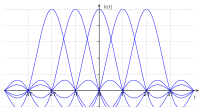
Photo from wikipedia
A 5G network’s use-case in the Internet of Things (IoT) is a breakthrough, offering networks the ability to handle billions of connected devices with the proper blend of speed, latency,… Click to show full abstract
A 5G network’s use-case in the Internet of Things (IoT) is a breakthrough, offering networks the ability to handle billions of connected devices with the proper blend of speed, latency, and cost. The IoT networks implemented in high-speed scenarios like intra and intervehicular communications in autonomous driving vehicles, high-speed vehicles, and trains will experience a Doppler effect. Orthogonal frequency-division multiplexing, the popular transmission technology for existing new-radio IoT (NR-IoT), is limited in providing reliable connections in high-speed vehicular scenarios. The performance of such system degrades with higher-order antenna configuration due to the lack of channel state information in highly mobile environments. The recently proposed orthogonal time-frequency space (OTFS) modulation is a strong contender that can handle high mobility but requires efficient transceiver design to be deployed in vehicular NR-IoT (V-IoT) systems. To conserve the resources and minimize the air time of the devices, we have proposed an embedded pilot design in the Delay–Doppler domain for the V-IoT systems. In the designed frame structure, the pilot’s position is optimized as per the vehicle speed to maximize the spectral efficiency of the system. The increase in spectral efficiency is at the cost of interference in the channel search region of the received Delay–Doppler domain OTFS signal. So a new joint estimator and the low-complex detector are proposed to handle the interference. The proposed efficient transceiver design with the spectral efficient pilot patterns allows us to conserve resources and remove complex encoder–decoders like the low-density parity check in NR-IoT.
Journal Title: IEEE Internet of Things Journal
Year Published: 2023
Link to full text (if available)
Share on Social Media: Sign Up to like & get
recommendations!